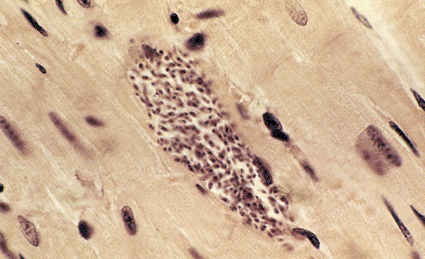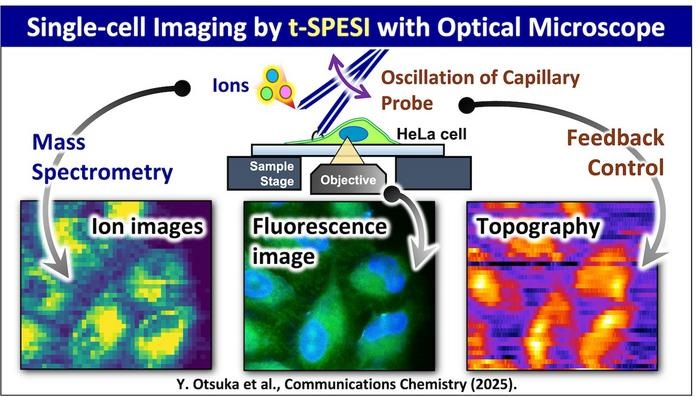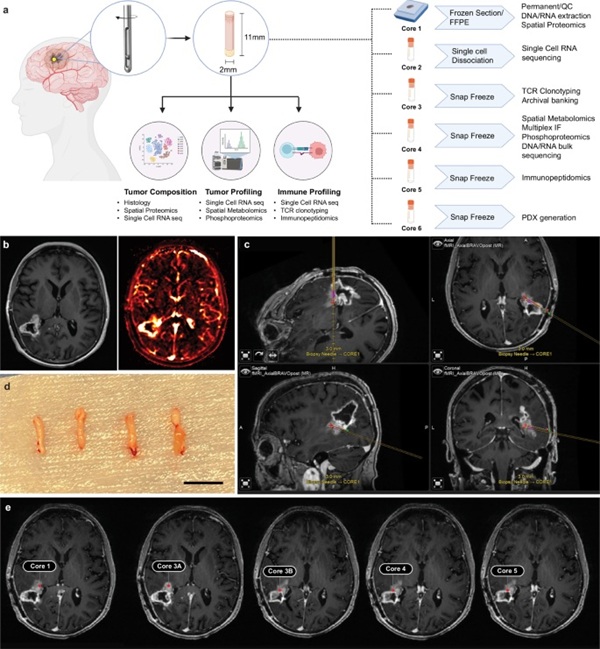Immunoassay Detects Antibodies to American Trypanosomiasis
|
By LabMedica International staff writers Posted on 11 Jan 2011 |

Image: Light micrograph of a section through a cluster of Trypanosoma cruzi protozoans (purple, center) in the heart muscle of a patient suffering from Chagas disease (Photo courtesy of Sinclair Stammers / Science Photo Library).
A fully automated immunoassay can determine the presence of antibodies to Trypanosoma cruzi, the causative agent of Chagas disease, in human serum and plasma.
The quantitative two-step chemiluminescent microparticle immunoassay (CMIA) has been compared to an enzyme linked immunoassays (ELISA) for specificity and sensitivity. In the first step, sample, assay diluent, and paramagnetic microparticles co-coated with four chimeric T. cruzi recombinant antigens, are combined. A murine acridinium-labeled antihuman immunoglobulin (IgG) conjugate is added. After another wash cycle, pre-trigger and trigger solutions are added to the reaction mixture.
The ARCHITECT Chagas prototype assay (Abbott GmbH & Co.; Wiesbaden-Delkenheim, Germany) was tested on total of 10, 284 specimens to determine the specificity and sensitivity of the assay. The tests were done in Abbott's laboratory in Germany and in external sites in Guatemala and Brazil.
Of 10,284 specimens tested, 9,629 had a final interpretation of T. cruzi antibody-negative based on the testing algorithm used, whereas 655 specimens were determined to be T. cruzi antibody-positive. In comparison with the ELISA cruzi assay (bioMérieux; Marcy l'Etoile, France; www.biomerieux.com), the ARCHITECT assay demonstrated superior specificity (99.99% vs. 99.93%) and sensitivity (99.85% vs. 98.38%), along with excellent precision. This suggests that this CMIA has the potential to serve as single assay to determine the T. cruzi status of a given blood unit or diagnostic specimen on a fully automated instrument platform.
The authors of the study concluded that the utility of the fully automated ARCHITECT Chagas assay can be used in the diagnostic setting and for blood donor testing in endemic as well as nonendemic regions. The assay, once it is commercially available, might be used as a single test for routine testing in high-prevalence areas such as South and Central America, which would enable an economic testing strategy being highly advantageous for the target countries. Chagas disease or American Trypanosomiasis represents the third largest tropical disease burden worldwide, after malaria and schistosomiasis. The study was published in January 2011, in Diagnostic Microbiology and Infectious Disease.
Related Links:
bioMérieux
Abbott
The quantitative two-step chemiluminescent microparticle immunoassay (CMIA) has been compared to an enzyme linked immunoassays (ELISA) for specificity and sensitivity. In the first step, sample, assay diluent, and paramagnetic microparticles co-coated with four chimeric T. cruzi recombinant antigens, are combined. A murine acridinium-labeled antihuman immunoglobulin (IgG) conjugate is added. After another wash cycle, pre-trigger and trigger solutions are added to the reaction mixture.
The ARCHITECT Chagas prototype assay (Abbott GmbH & Co.; Wiesbaden-Delkenheim, Germany) was tested on total of 10, 284 specimens to determine the specificity and sensitivity of the assay. The tests were done in Abbott's laboratory in Germany and in external sites in Guatemala and Brazil.
Of 10,284 specimens tested, 9,629 had a final interpretation of T. cruzi antibody-negative based on the testing algorithm used, whereas 655 specimens were determined to be T. cruzi antibody-positive. In comparison with the ELISA cruzi assay (bioMérieux; Marcy l'Etoile, France; www.biomerieux.com), the ARCHITECT assay demonstrated superior specificity (99.99% vs. 99.93%) and sensitivity (99.85% vs. 98.38%), along with excellent precision. This suggests that this CMIA has the potential to serve as single assay to determine the T. cruzi status of a given blood unit or diagnostic specimen on a fully automated instrument platform.
The authors of the study concluded that the utility of the fully automated ARCHITECT Chagas assay can be used in the diagnostic setting and for blood donor testing in endemic as well as nonendemic regions. The assay, once it is commercially available, might be used as a single test for routine testing in high-prevalence areas such as South and Central America, which would enable an economic testing strategy being highly advantageous for the target countries. Chagas disease or American Trypanosomiasis represents the third largest tropical disease burden worldwide, after malaria and schistosomiasis. The study was published in January 2011, in Diagnostic Microbiology and Infectious Disease.
Related Links:
bioMérieux
Abbott
Latest Hematology News
- First Point-of-Care Heparin Monitoring Test Provides Results in Under 15 Minutes

- New Scoring System Predicts Risk of Developing Cancer from Common Blood Disorder
- Non-Invasive Prenatal Test for Fetal RhD Status Demonstrates 100% Accuracy
- WBC Count Could Predict Severity of COVID-19 Symptoms
- New Platelet Counting Technology to Help Labs Prevent Diagnosis Errors
- Streamlined Approach to Testing for Heparin-Induced Thrombocytopenia Improves Diagnostic Accuracy
- POC Hemostasis System Could Help Prevent Maternal Deaths
- New Test Assesses Oxygen Delivering Ability of Red Blood Cells by Measuring Their Shape
- Personalized CBC Testing Could Help Diagnose Early-Stage Diseases in Healthy Individuals
- Non-Invasive Test Solution Determines Fetal RhD Status from Maternal Plasma
- First-Of-Its-Kind Smartphone Technology Noninvasively Measures Blood Hemoglobin Levels at POC

- Next Gen CBC and Sepsis Diagnostic System Targets Faster, Earlier, Easier Results
- Newly Discovered Blood Group System to Help Identify and Treat Rare Patients
- Blood Platelet Score Detects Previously Unmeasured Risk of Heart Attack and Stroke
- Automated Benchtop System to Bring Blood Testing To Anyone, Anywhere
- New Hematology Analyzers Deliver Combined ESR and CBC/DIFF Results in 60 Seconds
Channels
Clinical Chemistry
view channel
AI-Powered Blood Test Accurately Detects Ovarian Cancer
Ovarian cancer ranks as the fifth leading cause of cancer-related deaths in women, largely due to late-stage diagnoses. Although over 90% of women exhibit symptoms in Stage I, only 20% are diagnosed in... Read more
Automated Decentralized cfDNA NGS Assay Identifies Alterations in Advanced Solid Tumors
Current circulating cell-free DNA (cfDNA) assays are typically centralized, requiring specialized handling and transportation of samples. Introducing a flexible, decentralized sequencing system at the... Read more
Mass Spectrometry Detects Bacteria Without Time-Consuming Isolation and Multiplication
Speed and accuracy are essential when diagnosing diseases. Traditionally, diagnosing bacterial infections involves the labor-intensive process of isolating pathogens and cultivating bacterial cultures,... Read more
First Comprehensive Syphilis Test to Definitively Diagnose Active Infection In 10 Minutes
In the United States, syphilis cases have surged by nearly 80% from 2018 to 2023, with 209,253 cases recorded in the most recent year of data. Syphilis, which can be transmitted sexually or from mother... Read moreMolecular Diagnostics
view channel
POC Diagnostic Platform Combines Immunoassay and Molecular Testing
An innovative diagnostic platform offers superior sensitivity across all sample types, including blood, compared to existing rapid tests, while maintaining a low-cost, user-friendly design.... Read more
Single Blood Test Could Detect Different Types of Cancer at Early Stages
Currently, reliable screening for only a few types of cancer is available, such as those affecting the breast, bowel, cervix (neck of the womb), and lung for individuals at high risk. While these screenings... Read moreImmunology
view channel
Stem Cell Test Predicts Treatment Outcome for Patients with Platinum-Resistant Ovarian Cancer
Epithelial ovarian cancer frequently responds to chemotherapy initially, but eventually, the tumor develops resistance to the therapy, leading to regrowth. This resistance is partially due to the activation... Read more
Machine Learning-Enabled Blood Test Predicts Immunotherapy Response in Lymphoma Patients
Chimeric antigen receptor (CAR) T-cell therapy has emerged as one of the most promising recent developments in the treatment of blood cancers. However, over half of non-Hodgkin lymphoma (NHL) patients... Read moreMicrobiology
view channel
New Blood Test Detects Up to Five Infectious Diseases at POC
Researchers have developed a prototype flow-through assay capable of detecting up to five different infections, with results that can be quickly analyzed and transmitted via a specialized smartphone app.... Read more
Molecular Stool Test Shows Potential for Diagnosing TB in Adults with HIV
Tuberculosis (TB), caused by the bacterium Mycobacterium tuberculosis, led to 1.25 million deaths in 2023, with 13% of those occurring in people living with HIV. The current primary diagnostic method for... Read morePathology
view channel
New Technology Improves Understanding of Complex Biological Samples
Tissues are composed of a complex mixture of various cell types, which complicates our understanding of their biological roles and the study of diseases. Now, a multi-institutional team of researchers... Read more
Combining Multiple Laboratory Techniques Provides Deeper Insights into Deadly Brain Tumors
Glioblastoma (GBM) is a highly aggressive primary brain cancer that currently has limited effective treatments. Stereotactic needle biopsies are commonly employed for diagnosis; however, their use is restricted... Read more
AI-Based Diagnosis System Identifies Malaria Parasites from Blood Smear Images
Malaria diagnosis has traditionally been performed manually via microscopic examination, a process that is not only time-consuming but also highly dependent on the expertise and accuracy of healthcare providers.... Read moreTechnology
view channel
Advanced Predictive Algorithms Identify Patients Having Undiagnosed Cancer
Two newly developed advanced predictive algorithms leverage a person’s health conditions and basic blood test results to accurately predict the likelihood of having an undiagnosed cancer, including ch... Read more
Light Signature Algorithm to Enable Faster and More Precise Medical Diagnoses
Every material or molecule interacts with light in a unique way, creating a distinct pattern, much like a fingerprint. Optical spectroscopy, which involves shining a laser on a material and observing how... Read more
Disposable Microchip Technology Could Selectively Detect HIV in Whole Blood Samples
As of the end of 2023, approximately 40 million people globally were living with HIV, and around 630,000 individuals died from AIDS-related illnesses that same year. Despite a substantial decline in deaths... Read more
Pain-On-A-Chip Microfluidic Device Determines Types of Chronic Pain from Blood Samples
Chronic pain is a widespread condition that remains difficult to manage, and existing clinical methods for its treatment rely largely on self-reporting, which can be subjective and especially problematic... Read moreIndustry
view channel
Qiagen Acquires NGS Analysis Software Company Genoox
QIAGEN (Venlo, the Netherlands) has signed a definitive agreement to acquire Genoox (Tel Aviv, Israel), a provider of artificial intelligence (AI)-powered software that enables clinical labs to scale and... Read more
Cepheid and Oxford Nanopore Technologies Partner on Advancing Automated Sequencing-Based Solutions
Cepheid (Sunnyvale, CA, USA), a leading molecular diagnostics company, and Oxford Nanopore Technologies (Oxford, UK), the company behind a new generation of sequencing-based molecular analysis technologies,... Read more
Grifols and Tecan’s IBL Collaborate on Advanced Biomarker Panels
Grifols (Barcelona, Spain), one of the world’s leading producers of plasma-derived medicines and innovative diagnostic solutions, is expanding its offer in clinical diagnostics through a strategic partnership... Read more









 Assay.jpg)







